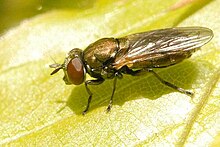Orthonevra
| Orthonevra | |
|---|---|

| |
| Orthonevra geniculata | |
| Scientific classification | |
| Domain: | Eukaryota |
| Kingdom: | Animalia |
| Phylum: | Arthropoda |
| Class: | Insecta |
| Order: | Diptera |
| Family: | Syrphidae |
| Subfamily: | Eristalinae |
| Tribe: | Brachyopini |
| Genus: | Orthonevra Macquart, 1829 |
| Type species | |
| Chrysogaster elegans | |
| Synonyms | |
| |
Orthonevra is a genus of fly in the Syrphidae family with at least 59 species identified so far. They are worldwide in distribution but concentrated in the Eastern North America and Europe.Orthonevra are commonly called Mucksuckers after the larvae which have been found in organic rich mud, i.e. muck. This genus belongs to the tribe Brachyopini that includes the prominent genera Melanogaster, Brachyopa, Neoascia and Sphegina.
Orthonevra have black heads with blue to purple reflections. Many species have distinctive eye stripes. The antennae are somewhat elongate. (see image) The frons is wrinkled with silvery spots at sides of antennae. The thorax with small punctures dorsally and in several species the body is covered with scale-like pile. Wingd vein M1 curves away from the wing tip.(see images)



Guides
[edit]Seman reviewed north american species as of 1964 [2] [3]
The most comprehensive of existing keys to European Orthonevra species is that of van Veen (2004), [4] M.C.D.Speight has also documented European species. [5]
Species
[edit]- Orthonevra aenethorax Kohli, Kapoor & Gupta, 1988[6]
- Orthonevra anniae (Sedman, 1966)
- Orthonevra argentina (Brèthes, 1922)[7]
- Orthonevra auritarsis Brădescu, 1992
- Orthonevra bellula (Williston, 1882)
- Orthonevra brevicornis (Loew, 1843)
- Orthonevra ceratura (Stackelberg, 1952)[8]
- Orthonevra chilensis (Thompson, 1999)
- Orthonevra elegans (Meigen, 1822)[1]
- Orthonevra erythrogona (Malm, 1863)
- Orthonevra feei (Moran and Skevington, 2019)[9]
- Orthonevra flukei (Sedman, 1964)
- Orthonevra frontalis (Loew, 1843)
- Orthonevra gemmula (Violovitsh, 1979)
- Orthonevra geniculata (Meigen, 1830)
- Orthonevra gewgaw (Hull, 1941)[7]
- Orthonevra incisa (Loew, 1843)
- Orthonevra intermedia (Lundbeck, 1916)[10]
- Orthonevra inundata (Violovitsh, 1979)[8]
- Orthonevra karumaiensis (Matsumura, 1916)[8]
- Orthonevra kozlovi (Stackelberg, 1952)[8]
- Orthonevra labyrinthops (Hull, 1944j)[7]
- Orthonevra minuta (Hull, 1945)
- Orthonevra montana Vujić, 1999
- Orthonevra neotropica (Shannon, 1925a)[7]
- Orthonevra nigrovittata (Loew, 1876)
- Orthonevra nitida (Wiedemann, 1830)
- Orthonevra nitidula (Curran, 1925)
- Orthonevra nobilis (Fallén, 1817)
- Orthonevra onytes (Séguy, 1961)
- Orthonevra parva (Shannon, 1916)
- Orthonevra pictipennis (Loew, 1863)
- Orthonevra plumbago (Loew, 1840)
- Orthonevra pulchella (Williston, 1887)
- Orthonevra quadristriata (Shannon & Aubertin, 1933)[7]
- Orthonevra robusta (Shannon, 1916)
- Orthonevra sachalinensis (Violovitsh, 1956)[8]
- Orthonevra shannoni (Curran, 1925a)[7]
- Orthonevra shusteri Brădescu, 1993
- Orthonevra sinuosa (Bigot, 1884)
- Orthonevra sonorensis (Shannon, 1964)
- Orthonevra stackelbergi Thompson & Torp, 1982
- Orthonevra stigmata (Williston, 1882)
- Orthonevra subincisa (Violovitsh, 1979)[8]
- Orthonevra tristis (Loew, 1871)
- Orthonevra unicolor (Shannon, 1916)
- Orthonevra vagabunda (Violovitsh, 1979)[8]
- Orthonevra varga (Violovitsh, 1979)[8]
- Orthonevra weemsi (Sedman, 1966)
References
[edit]- ^ a b Meigen, Johann Wilhelm (1822). Systematische Beschreibung der bekannten europäische n zweiflugeligen Insekten. Hamm: Dritter Theil. Schulz-Wundermann. pp. x, 416, pls. 22–32. Retrieved 14 April 2019.
- ^ Sedman, Yale S (1964). "The Chrysogaster (Orthonevra) Bellula Group In North America". Proceedings of the Entomological Society of Washington. 66: 169–201.
- ^ Sedman, Y. S. (1966). "The Chrysogaster (Orthonevra) pictipennis group in North America". Proceedings of the Entomological Society of Washington. 68: 185–194.
- ^ Van Veen, M.P. (2004). Hoverflies of Northwest Europe, Identification Keys to the Syrphidae (Hardback). Utrecht: KNNV Publishing. p. 254. ISBN 90-5011-199-8.
- ^ Speight, M.C.D (2011). Species accounts of European Syrphidae (Diptera), Glasgow2011 (PDF). Dublin: Syrph the Net publications.
- ^ Kohli, V. K.; Kapoor, V. C.; Gupta, S. K. (1988). "On one new genus and nine species of syrphid flies (Diptera: Syrphidae) from India". Journal of Insect Science. 1. The Entomological Society of America: 113–127.
- ^ a b c d e f Thompson, F. C.; Vockeroth, J. R.; Sedman, Y. S. "A Catalogue of the Americas South of the United States: Family Syrphidae". São Paulo, Brasil: Museu de Zoologia. Retrieved 2 February 2011.
- ^ a b c d e f g h Barkalov, A.V. "Syrphidae collection of Siberian Zoological Museum". Novosibirsk, Russia: the Institute of Animal Systematics and Ecology, Siberian Branch of the Russian Academy of Sciences. Archived from the original on October 20, 2008. Retrieved 28 July 2009.
- ^ Skevington, Jeffrey (2019). "New Syrphidae (Diptera) of North-eastern North America". biodiversity Data Journal.
- ^ Drake, C. Martin (2006). "Orthonevra intermedia Lundbeck, 1916 (Diptera, Syrphidae) new to Britain". Dipterists Digest. second series. 13 (2). UK: Dipterists Forum: 87–91. ISSN 0953-7260.
